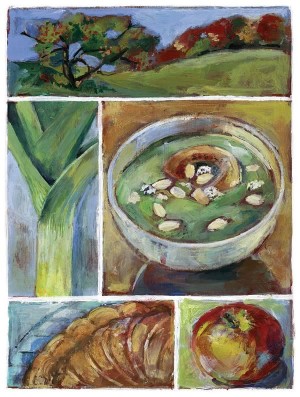Cooler days Warmer food
Our main course, a succulent leg of lamb, takes advantage of the season’s apple harvest. We suggest serving this meal with roasted root vegetables.

Leeks have been used by cooks to add zest to meals for thousands of years. Illustration by Shelagh Armstrong.
As the days grow chillier, soups turn from cold to piping hot. Our autumn repast begins with a nice and peppery leek and spinach soup. The recipe would work equally well with butternut squash.
Leeks are less potent than their onion relatives and are suited perfectly for stews and soups. The smaller the leek, the more tender it will be. Leeks have been used by cooks to add zest to meals for thousands of years. Nero thought that consuming large quantities would help his singing, and the Welsh made the leek their national symbol, believing it helped them win wars.
Our main course, a succulent leg of lamb, takes advantage of the season’s apple harvest. We suggest serving this meal with roasted root vegetables.
The easiest way to judge the age of a leg of lamb is by weight. A higher quality weighs about two kilograms. It is best to buy two smaller legs than to purchase one over four kilograms. The flesh should be pink; the darker the colour of the flesh, the older the animal. Lamb legs are covered with fat and fell, which should not be removed prior to preparing.
The gâteau for dessert is named after the town of Pithiviers, between Paris and Orleans. This classic cake has a frangipane (almond cream) filling and is best served lukewarm with ice cream. For best flavour, use freshly shelled nuts for the filling. To remove the thin skin on the almonds, immerse them in boiling water, then place them into cold water, and pop the nuts out of their skin. Roasting or toasting the nuts will bring out more flavour. Place them in the oven at 350°F for about 10 minutes.
Spinach Soup
- 2 firm apples
- 1 tbsp | 15 ml butter
- 2 lb | 1 kg spinach
- 2 leeks, cleaned and sliced
- 2 tbsp | 30 ml butter
- ½ onion, chopped
- ½ c | 75 ml crumbled feta cheese
- ½ c | 75 ml whipping cream
- 3 c | 750 ml chicken or vegetable stock
- salt and freshly ground pepper
Strip the stems from the spinach. Wash the leaves well. In a large pot, melt the 2 tablespoons of butter and add the chopped onion and leek. Cover and cook slowly until onion is translucent. Add the stock, spinach and salt and pepper, and bring to the boil. Reduce and simmer for 15 minutes. Reduce the heat and add the whipping cream. Do not boil.
Peel the apple and cut in half. Remove the core. Melt the remaining 1 tablespoon of butter in a pan. Place the apples in, cut side down, and cook until golden brown on both sides.
Place the soup in a blender and purée. Ladle the soup into bowls and set the apple, cut side up, into the bowl. Scatter feta cheese over the soup and serve. Serves 4.
Maple Glazed Lamb Leg with Apple Cider
- 5lb | 2.5 kg leg of lamb
- 3 garlic cloves
- ½ c | 75 ml maple syrup
- 4 firm apples, peeled and cored
- 2 c | 500 ml hard cider
- 1 c | 250 ml chicken stock
Trim the tough outer skin (fell) and some of the fat from the lamb. Score the skin in a criss-cross pattern. Rub olive oil into the lamb and sprinkle with salt and pepper. Halve the garlic cloves. Place the garlic into the pan.
Place in a roasting pan. Add the apples and bake in a preheated 4oo°F oven for 2o minutes. Remove from the oven, pour the cider over top and then brush the lamb with the maple syrup. Cook for a further 20 minutes and repeat with the other side of the lamb. Baste with the cider in the pan and brush with the maple syrup.
Bake for a total of 1¼ hours, or until the lamb registers rare or medium-rare on a meat thermometer. Set aside and purée the juices and apple in the pan for gravy. Adjust seasoning.
GÂteau Pithiviers
- 2 packages puff pastry
- beaten egg
- icing sugar to dust
- ¾ c | 185 ml ground almonds
- ¾ c | 185 ml sugar
- 4 tbsp | 60 ml butter
- 2 egg yolks
- 2 tbsp | 30 ml rum
- ½ tsp | 2 ml vanilla
Beat the almonds, sugar and butter together with the egg yolks, rum and vanilla until the paste whitens.
Roll the pastry out to ¼” thickness and then cut out two 1o” circles. Spread the filling on the top of one of the rounds of dough, leaving a 1″ lip. Moisten this edge with water and place the other puff pastry round on top. Press the rounds together and refrigerate for 20 minutes. Press around the edges with your thumb. Using a butter knife, make indentations beside the thumb to create notches.
Brush the top of the cake with the beaten egg. Using a knife, create concentric lines from the outer edge of the cake to the centre. With the point of a knife, make a hole in the centre of the top pastry.
Bake at 4oo°F for about 25 minutes. Lower heat to 375°F and dust the top of the cake with icing sugar. Return to the oven to caramelize. Serve lukewarm. Serves 8.






